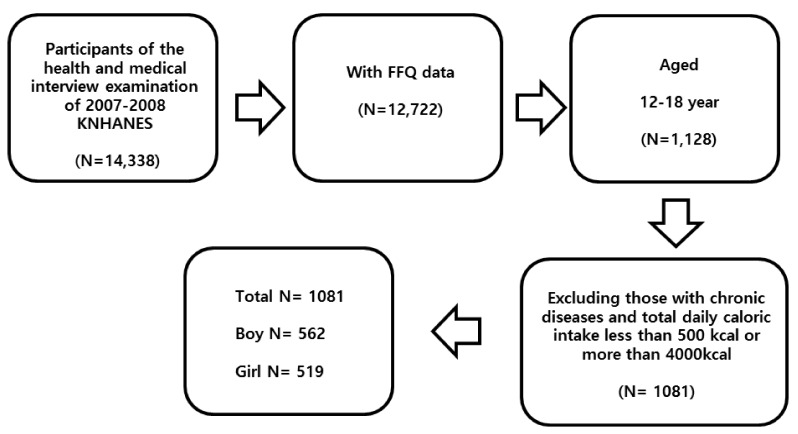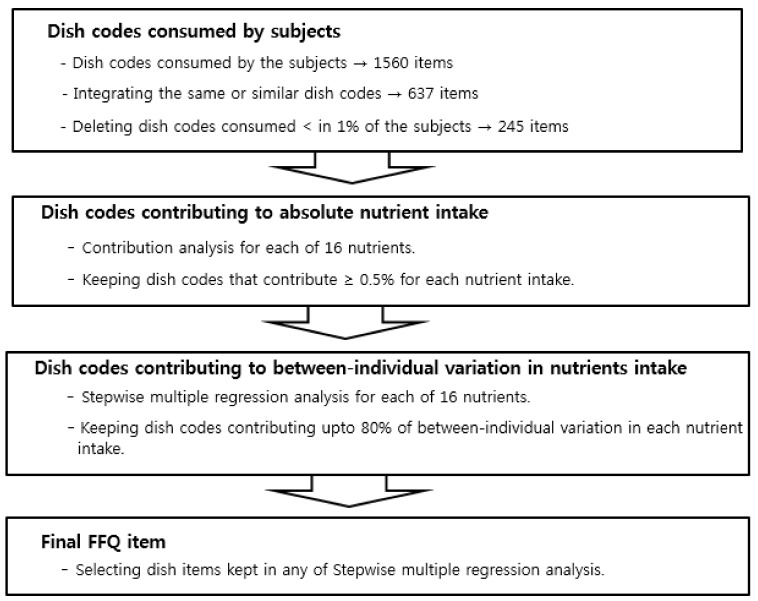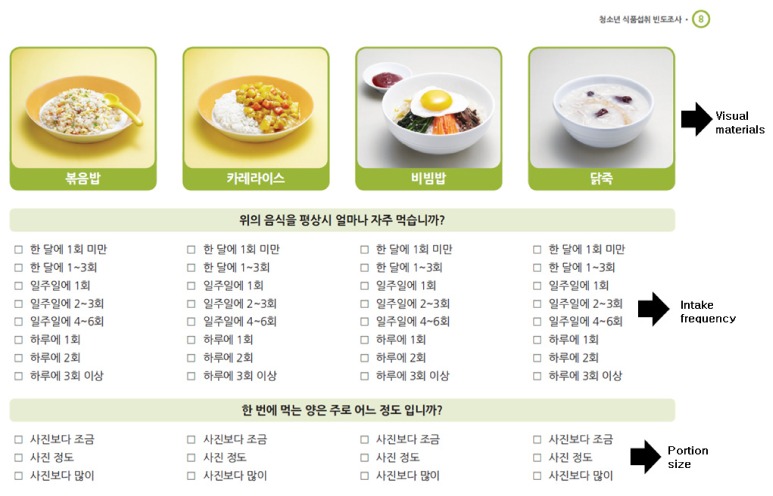Nutr Res Pract.
2016 Aug;10(4):433-441. 10.4162/nrp.2016.10.4.433.
Development and evaluation of a dish-based semiquantitative food frequency questionnaire for Korean adolescents
- Affiliations
-
- 1Department of Food and Nutrition, Sungshin Women's University, 55, Dobong-ro 76 ga-gil, Gangbuk-gu, Seoul 01133, Korea. smlee@sungshin.ac.kr
- KMID: 2390147
- DOI: http://doi.org/10.4162/nrp.2016.10.4.433
Abstract
- BACKGROUND/OBJECTIVES
The purpose of this study was to develop a dish-based semiquantitative food frequency questionnaire s(FFQ) for Korean adolescents and evaluate its reproducibility and validity.
SUBJECTS/METHODS
Based on 24-hour dietary recall data from the 4th Korean National Health and Nutrition Examination Survey (KNHANES), we developed a FFQ with 71 items. From a quota sample of 160 adolescents recruited using gender and age group as stratification variables, 153 participated in the complete data collection process. The FFQ was administered to each subject twice, at an interval of 3-4 weeks, to evaluate the test-retest reliability. The validity of the FFQ was assessed relative to 8-day food record data.
RESULTS
The study findings demonstrated the FFQ's satisfactory reproducibility. Spearman correlation coefficients ranged from 0.64(for β-carotene) to 0.81(for protein). From cross-classification analyses, the proportion of subjects in the same intake quartile was highest for protein (65.4%) and lowest for vitamin A(47.1%). With regard to validity analysis, Spearman correlation coefficients ranged from 0.27(for vitamin A and fiber) to 0.90 (for energy). The proportions of subjects in the opposite categories between the first FFQ and the 8-day food record data were generally low within the range from 0.74% (for energy and carbohydrate) to 13.2% (for α-carotene).
CONCLUSIONS
In conclusion, the dish-based semiquantitative FFQ developed in this study can be useful for grouping Korean adolescents according to major macro- and micronutrient intakes with reasonable reproducibility and validity.
Keyword
MeSH Terms
Figure
Cited by 3 articles
-
Dietary risk factors for urolithiasis in Korea: A case-control pilot study
Ho Young Ryu, You Kyoung Lee, Juhyun Park, Hwancheol Son, Sung Yong Cho
Investig Clin Urol. 2018;59(2):106-111. doi: 10.4111/icu.2018.59.2.106.Gender Analysis of Food Items Selection for Food Frequency Questionnaire Development
Minji Kang, Jung Eun Lee, Jae Eun Shim, Hee-Young Paik
Korean J Health Promot. 2018;18(2):98-106. doi: 10.15384/kjhp.2018.18.2.96.Development of a semi-quantitative food frequency questionnaire for dietary intake of elementary school children: data from the Seventh Korea National Health and Nutrition Examination Survey
Minji Jung, Eunhee Ha, Oran Kwon, Hyesook Kim
Nutr Res Pract. 2023;17(4):747-761. doi: 10.4162/nrp.2023.17.4.747.
Reference
-
1. Willet W. Nutritional Epidemiology. 2nd ed. New York (NY): Oxford University Press;1998.2. Ministry of Health and Welfare. Korea Centers for Disease Control and Prevention. In-depth Analysis on the 2013 Korea National Health and Nutrition Examination Survey (KNHANES VI-1): Nutrition Survey. Cheongwon: Ministry of Health and Welfare;2014.3. Ministry of Health and Welfare. Korea Centers for Disease Control and Prevention. In-depth Analysis on the 2005 Korea National Health and Nutrition Examination Survey (KNHANES III): Nutrition Survey. Cheongwon: Ministry of Health and Welfare;2006.4. Rockett HR, Wolf AM, Colditz GA. Development and reproducibility of a food frequency questionnaire to assess diets of older children and adolescents. J Am Diet Assoc. 1995; 95:336–340. PMID: 7860946.
Article5. Yaroch AL, Resnicow K, Davis M, Davis A, Smith M, Khan LK. Development of a modified picture-sort food frequency questionnaire administered to low-income, overweight, African-American adolescent girls. J Am Diet Assoc. 2000; 100:1050–1056. PMID: 11019353.
Article6. Matthys C, Pynaert I, De Keyzer W, De Henauw S. Validity and reproducibility of an adolescent web-based food frequency questionnaire. J Am Diet Assoc. 2007; 107:605–610. PMID: 17383266.
Article7. Watson JF, Collins CE, Sibbritt DW, Dibley MJ, Garg ML. Reproducibility and comparative validity of a food frequency questionnaire for Australian children and adolescents. Int J Behav Nutr Phys Act. 2009; 6:62. PMID: 19744349.
Article8. Buzzard IM, Stanton CA, Figueiredo M, Fries EA, Nicholson R, Hogan CJ, Danish SJ. Development and reproducibility of a brief food frequency questionnaire for assessing the fat, fiber, and fruit and vegetable intakes of rural adolescents. J Am Diet Assoc. 2001; 101:1438–1446. PMID: 11762739.
Article9. Vereecken CA, Maes L. A Belgian study on the reliability and relative validity of the Health Behaviour in School-Aged Children food-frequency questionnaire. Public Health Nutr. 2003; 6:581–588. PMID: 14690039.
Article10. Jensen JK, Gustafson D, Boushey CJ, Auld G, Bock MA, Bruhn CM, Gabel K, Misner S, Novotny R, Peck L, Read M. Development of a food frequency questionnaire to estimate calcium intake of Asian, Hispanic, and white youth. J Am Diet Assoc. 2004; 104:762–769. PMID: 15127061.
Article11. Zemel BS, Carey LB, Paulhamus DR, Stallings VA, Ittenbach RF. Quantifying calcium intake in school age children: development and validation of the Calcium Counts! Food frequency questionnaire. Am J Hum Biol. 2010; 22:180–186. PMID: 19621431.12. Stiegler P, Sausenthaler S, Buyken AE, Rzehak P, Czech D, Linseisen J, Kroke A, Gedrich K, Robertson C, Heinrich J. A new FFQ designed to measure the intake of fatty acids and antioxidants in children. Public Health Nutr. 2010; 13:38–46. PMID: 19476676.
Article13. Paik HY, Ryu JY, Choi JS, Ahn YJ, Moon HK, Park YS, Lee HK, Kim YI. Development and validation of food frequency questionnaire for dietary assessment of Korean adults in rural area. Korean J Nutr. 1995; 28:914–922.14. Kim MK, Lee SS, Ahn YO. Reproducibility and validity of a self-administered semiquantitative food frequency questionnaire among middle-aged men in Seoul. Korean J Community Nutr. 1996; 1:376–394.15. Lee HJ, Lee HS, Ha MJ, Kye SH, Kim CI, Lee CW, Yoon JS. The development and evaluation of a simple semi-quantitative food frequency questionnaire to assess the dietary intake of adults in large cities. Korean J Community Nutr. 1997; 2:349–365.16. Oh SY, Hong MH. Repeatability of a semi-quantitative food frequency questionnaire or the Korean elderly. Korean J Nutr. 1998; 31:1183–1191.17. Won HS, Kim WY. Development and validation of a semi-quantitative food frequency questionnaire to evaluate nutritional status of Korean elderly. Korean J Nutr. 2000; 33:314–323.18. Lee HJ, Park SJ, Kim JH, Kim CI, Chang KJ, Yim KS, Kim KW, Choi HM. Development and validation of a computerized semi-quantitative food frequency questionnaire program for evaluating the nutritional status of the Korean Elderly. Korean J Community Nutr. 2002; 7:277–285.19. Ahn Y, Kwon E, Shim JE, Park MK, Joo Y, Kimm K, Park C, Kim DH. Validation and reproducibility of food frequency questionnaire for Korean genome epidemiologic study. Eur J Clin Nutr. 2007; 61:1435–1441. PMID: 17299477.
Article20. Yim KS, Lee TY, Park HS. The development and validation of a food frequency questionnaire to assess diets of Korean adolescents. Korean J Community Nutr. 2003; 8:149–159.21. Hernandez-Avila M, Master C, Hunter DJ, Buring J, Philips J, Willett WC. Influence of additional portion size data on the validity of a semi-quantitative food frequency questionnaire. Am J Epidemiol. 1988; 128:891.22. Lee SM. Development and evaluation of a brief fruit and vegetable food frequency questionnaire for higher-grade elementary school child. J East Asian Soc Diet Life. 2008; 18:675–683.23. Zhuang M, Yuan Z, Lin L, Hu B, Wang X, Yang Y, Chen X, Jin L, Lu M, Ye W. Reproducibility and relative validity of a food frequency questionnaire developed for adults in Taizhou, China. PLoS One. 2012; 7:e48341. PMID: 23139777.
Article24. Willett WC, Sampson L, Stampfer MJ, Rosner B, Bain C, Witschi J, Hennekens CH, Speizer FE. Reproducibility and validity of a semiquantitative food frequency questionnaire. Am J Epidemiol. 1985; 122:51–65. PMID: 4014201.
Article25. Martin-Moreno JM, Boyle P, Gorgojo L, Maisonneuve P, Fernandez-Rodriguez JC, Salvini S, Willett WC. Development and validation of a food frequency questionnaire in Spain. Int J Epidemiol. 1993; 22:512–519. PMID: 8359969.
Article26. Nematy M, Nouri M, Ghazizahedi S, Norouzy A, Mohajeri SA, Shalaei N, Safariyan M, Esmaily H. Validity and reproducibility of Iranian food frequency questionnaire. Switz Res Park J. 2013; 102:2137–2146.27. Willett W. Food frequency methods. In : Willett W, editor. Nutritional Eepidemiology. New York (NY): Oxford University Press;1990. p. 69–91.28. Kim WY, Yang EJ. A study on development and validation of food frequency questionnaire for Koreans. Korean J Nutr. 1998; 31:220–230.29. Rimm EB, Giovannucci EL, Stampfer MJ, Colditz GA, Litin LB, Willett WC. Reproducibility and validity of an expanded self-administered semiquantitative food frequency questionnaire among male health professionals. Am J Epidemiol. 1992; 135:1114–1126. PMID: 1632423.
Article30. Kobayashi T, Kamimura M, Imai S, Toji C, Okamoto N, Fukui M, Date C. Reproducibility and validity of the food frequency questionnaire for estimating habitual dietary intake in children and adolescents. Nutr J. 2011; 10:27. PMID: 21429227.
Article31. Kim MK, Yun YM, Kim YO. Developing dish-based food frequency questionnaire for the epidemiology study of hypertension among Korean. Korean J Community Nutr. 2008; 13:701–712.32. Yun SH, Shim JS, Kweon S, Oh K. Development of a food frequency questionnaire for the Korea National Health and Nutrition Examination Survey: data from the Fourth Korea National Health and Nutrition Examination Survey (KNHANES IV). Korean J Nutr. 2013; 46:186–196.
Article
- Full Text Links
- Actions
-
Cited
- CITED
-
- Close
- Share
- Similar articles
-
- A Study of the Dietary Intake Status and One Portion Size of Commonly Consumed Food and Dishes in Korean Elderly Women
- Application and Evaluation of Web-based Food Frequency Questionnaire for Korean Adolescents
- Developing Dish-based Food Frequency Questionnaire for the Epidemiology Study of Hypertension Among Korean
- Comparison of major dish item and food group consumption between normal and obese Korean children: application to development of a brief food frequency questionnaire for obesity-related eating behaviors
- Development of a food frequency questionnaire for dietary intake of preschool children






